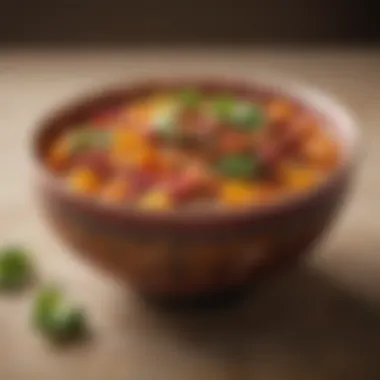Harina Pan: Cultural Significance and Culinary Insights


Intro
Harina Pan is a type of flour produced from precooked corn, extensively utilized across Latin American cuisines. Not only is it a staple in dishes like arepas, but it also carries deep cultural significance within various communities. Understanding Harina Pan's roots and its versatile applications offers valuable insights for culinary enthusiasts who wish to broaden their cooking skills.
Recipe Overview
Harina Pan is primarily known for its main application in arepas, a round flatbread that originated in Venezuela and Colombia. This staple is cherished in many Latin American homes; it represents comfort and tradition.
The cultural significance of arepas transcends mere sustenance. They are often enjoyed during family gatherings and celebrations, symbolizing togetherness and heritage. Each family often has their own traditional recipes, reflecting regional flavors and personal preferences.
Ingredients List
To make a basic arepa, here is the complete list of ingredients:
- 2 cups of Harina Pan
- 2 cups of warm water
- 1 teaspoon of salt
Special Ingredient Notes
- Harina Pan: The key ingredient, ensuring the right texture. For those who may not have access to Harina Pan, an alternative is masa harina, although results can differ in flavor and consistency.
- Warm Water: Using warm water helps to dissolve the flour easily, resulting in a smoother dough.
- Salt: While it's optional, adding salt enhances the flavor of the arepas.
Preparation Techniques
Making arepas is simple and accessible. The dough can be prepared in a few easy steps:
- In a bowl, mix Harina Pan and salt together.
- Gradually add warm water while mixing until a dough forms. Adjust the water content for the desired consistency.
- Let the dough rest for about 5-10 minutes to hydrate the flour fully.
- Divide the dough into portions and shape them into flat discs.
Cooking methods vary; arepas can be grilled, fried, or baked. Each method gives a unique texture and flavor.
"Arepas are more than just delicious; they are a culinary reflection of culture and history."
Prolusion to Harina Pan
Harina Pan is a significant ingredient in many culinary traditions, particularly within Latin American cuisine. This pre-cooked corn flour holds a special place in various dishes, making it a staple in households and restaurants alike. Understanding what Harina Pan is and its applications can enhance your cooking experience and appreciation for these culinary traditions.
The importance of introducing Harina Pan lies in its versatility and cultural significance. This flour is the foundation for some of the most beloved Latin American dishes, such as arepas and empanadas. Its unique texture and flavor profile can elevate any meal, offering both practicality and authenticity to home cooks.
Moreover, exploring Harina Pan invites food lovers to connect with the stories and histories that are woven into the recipes that utilize this ingredient. It transcends basic nourishment, representing cultural identity and community bonding through shared meals. When one understands how Harina Pan fits into these broader cultural contexts, cooking becomes not just a daily task but an exploration of heritage and traditions.
Key Points to Consider:
- Versatile Culinary Applications: Harina Pan can be used in various dishes beyond traditional recipes. This versatility allows for creative culinary adaptations, merging classic techniques with modern flavors.
- Historical Context: Knowing the origins and evolution of Harina Pan enriches one’s experience in using it, enhancing not only flavor but also the appreciation of its cultural roots.
- Nutritional Benefits: As a gluten-free flour option, Harina Pan caters to dietary needs while maintaining essential nutrients. Understanding its nutritional value is crucial for health-conscious cooks.
In summary, the introduction to Harina Pan sets the stage for a deeper dive into its historical background, production processes, and culinary applications. It serves as a bridge connecting culture and cuisine, allowing for an enriched cooking experience.
Historical Background of Harina Pan
Understanding the historical context of Harina Pan is essential for appreciating its cultural and culinary relevance today. This flour, made from precooked corn, stems from a rich tradition that values corn not only as a staple food but also as a symbol of identity and community in various Latin American cultures. By examining the origins and significance of Harina Pan, we can better comprehend its role in contemporary gastronomy and its potential future applications.
Origin of Harina Pan
Harina Pan originates from Venezuela, a country where corn has been harvested and consumed for thousands of years. The process of making this flour involves cooking corn kernels and then drying and grinding them into fine particles. This unique preparation method contributes to its distinct flavor and texture, making it suitable for various dishes.
The introduction of Harina Pan to other regions took place through migration. As Venezuelans and other Latin Americans dispersed globally, they brought their culinary traditions along, including the use of Harina Pan. Hence, it became more widely accessible, creating new opportunities for its incorporation into various cuisines.


Cultural Significance in Latin America
In Latin America, corn holds significant cultural importance, often being associated with myths, rituals, and community gatherings. The use of Harina Pan transcends simple nutrition; it forms the basis for social interactions. For instance, making arepas with family and friends is not just about the food but also about sharing moments and traditions.
Moreover, several dishes are tied to national identities, further emphasizing Harina Pan’s role in fostering a sense of belonging. From arepas to empanadas, these dishes celebrate regional flavors and ingredients, showcasing the families’ historical roots.
"Harina Pan is not merely a cooking ingredient; it embodies the rich history and cultural identity of the regions where corn has been a central element of sustenance."
The cultivation and consumption of corn-derived products like Harina Pan can be seen as an enduring legacy that highlights the intersection of past and present culinary practices. Its relevance continues to evolve, bridging gaps between tradition and modernity.
Understanding the Production Process
The production process of Harina Pan is crucial to understanding its quality and culinary applications. This section clarifies how the transformation of corn into flour influences the taste, nutritional value, and usability of the end product. Grasping the intricacies of this process helps consumers and cooks appreciate the significance of Harina Pan beyond its role as just another ingredient.
From Corn to Flour
Producing Harina Pan begins with selecting high-quality corn. The corn undergoes a unique process of cooking and drying, known as precooking. This preparation enhances flavor and preserves nutrients. The method allows the corn to be processed into flour without losing its essential qualities.
- Selection of Corn: The right type of corn is vital. Varieties like yellow corn are often preferred due to their richer flavor profile.
- Precooking: The chosen corn kernels are cooked in water, sometimes with lime. This step not only softens the kernels but also helps in releasing their nutrients.
- Drying and Grinding: Once cooked, the corn is dried. Afterward, it gets ground into a fine powder. The grinding must be consistent to ensure quality flour.
These steps combine to yield a flour that is rich in texture and flavor, ready for various culinary applications.
Industrial vs. Artisanal Methods
The methods of producing Harina Pan can broadly be classified into industrial and artisanal processes. Each has distinct characteristics that affect the final product's quality and availability.
- Industrial Production: This method leverages large-scale machinery and streamlined processes. Industrial techniques can produce large quantities quickly. While consistent, they may lack the unique flavors often associated with smaller batches. The focus is on efficiency and cost-effectiveness, often leading to a loss of some nutritional elements.
- Artisanal Production: In contrast, the artisanal approach emphasizes traditional techniques. Producers often rely on manual labor and time-honored practices. This method can yield a more flavorful and nutrient-dense flour. Artisanal methods often involve local sourcing of corn, supporting community economies, and emphasizing regional flavors.
Both methods have their merits, and consumer preference may vary based on factors like taste, sustainability, and ethical considerations. Understanding these differences can guide culinary enthusiasts in their choice of Harina Pan. Remember, the quality of flour impacts the dishes you create.
The choice between industrial and artisanal methods can influence the flavor profile and nutritional content of Harina Pan, affecting its diverse culinary applications and benefits.
Culinary Uses of Harina Pan
The culinary uses of Harina Pan extend beyond mere nourishment. This handy ingredient serves as a foundation for traditional and modern recipes, showcasing its versatility in many kitchens worldwide. Understanding these uses is crucial for grasping its significance in Latin American cuisine and beyond. Harina Pan is prized for its unique flavor and texture. It facilitates not just sustenance but also cultural expression through food.
Traditional Dishes Featuring Harina Pan
Arepas
Arepas are a staple in Venezuelan and Colombian diets. Made primarily from Harina Pan, they are popular for their versatility and ease of preparation. The distinct texture of arepas, created by cooking the dough on a hot griddle, makes them a satisfying option for many meals throughout the day. A key characteristic of arepas is their ability to be filled with various ingredients, ranging from cheese to meats and vegetables.
They offer a practical solution for both quick lunches and elaborate dinners. Furthermore, the use of Harina Pan ensures that arepas are gluten-free, appealing to those with specific dietary needs. As a culturally significant dish, they are not merely food; they embody heritage and tradition. This enriches the culinary landscape.
Empanadas
Empanadas are another delightful dish made with Harina Pan, known for their delectable fillings. These pockets can be baked or fried, providing a crispy exterior and savory interior. The hallmark of empanadas lies in their fillings, which can vary significantly. From spiced beef to sweet fruits, the possibilities are endless. This adaptability makes empanadas an interesting ingredient in discussions about Harina Pan's versatility.
One advantage is their potential for creativity, allowing cooks to experiment with flavors. However, there is a downside, as some may find the frying process less healthy due to added oils. Nevertheless, empanadas maintain enduring popularity across various regions.
Cachapas
Cachapas offer a sweet twist on Harina Pan’s uses. This corn pancake is traditionally filled with cheese. Their unique feature is the balance between sweetness and the savory flavor of the cheese. They are also thicker than arepas, which gives them a hearty appeal. Cachapas celebrate local ingredients, as they can be made using fresh corn and paired with different cheeses, enhancing the flavor profile.
The downside might be that not everyone is familiar with cachapas outside Latin America. Nevertheless, they exemplify the blend of simple ingredients into something special and satisfying. Their presence in any discussion about Harina Pan illustrates its cultural significance.


Modern Adaptations and Creative Recipes
As food culture evolves, so does the potential for Harina Pan in modern kitchens. Chefs and home cooks widely experiment with it, infusing global influences into traditional dishes. From Harina Pan pizza crusts to incredible tacos made with the flour, the options are seemingly limitless.
Some creative recipes include:
- Harina Pan Pizza: This innovates the traditional crust technique, appealing to those seeking gluten-free alternatives.
- Sweet Treats: Desserts like Harina Pan cookies provide a unique twist on baking, incorporating flavors beyond the traditional.
- Casseroles and Bakes: Harina Pan can also function as a binder, adding texture and flavor.
The uses of Harina Pan in both classic and modern recipes showcase its hybrid nature. It serves as a bridge between tradition and contemporary culinary arts, beneficial for both cooks and diners.
Nutritional Profile of Harina Pan
Understanding the nutritional profile of Harina Pan is crucial for both culinary enthusiasts and health-conscious individuals. This flour, made from precooked corn, offers distinct advantages that resonate with various dietary needs. Its composition provides a balance of essential nutrients, making it a viable option for a variety of diets.
Nutritional Benefits
Harina Pan boasts a number of nutritional benefits that make it a valuable addition to meals. Here are some key points about its nutrient content:
- Carbohydrates: It is high in carbohydrates, which are a primary source of energy. This is particularly beneficial for those needing sustained energy throughout the day, such as active individuals or athletes.
- Fiber: A significant amount of dietary fiber is present in Harina Pan, promoting digestive health. Adequate fiber intake contributes to better gut function and can help manage weight by increasing satiety.
- Vitamins and Minerals: Harina Pan contains important vitamins and minerals, such as vitamin B6, magnesium, and iron. These nutrients play roles in metabolic processes and maintaining overall health.
It's worth noting that the nutritional benefits may vary slightly based on the production methods, whether from industrial or artisanal sources.
"The nutritional profile of Harina Pan makes it a versatile ingredient for various culinary applications while meeting dietary needs."
Gluten-Free Considerations
One of the most appealing aspects of Harina Pan is that it is naturally gluten-free. This characteristic provides options for individuals with celiac disease or gluten sensitivities. Here are some considerations regarding gluten-free consumption:
- Safe for Celiac Disease: Those diagnosed with celiac disease can safely incorporate Harina Pan into their diets, as it does not contain gluten.
- Cross-Contamination: It is essential to check for cross-contamination in products. While Harina Pan itself is gluten-free, others handling it may not maintain strict separation from gluten-containing ingredients.
- Alternative for Baked Goods: For those looking to replace traditional flours, Harina Pan can serve as an excellent base for various baked goods, enhancing texture without gluten-related concerns.
Cultural Variations of Harina Pan Across the Globe
The cultural variations of Harina Pan are vital to understanding its place in global cuisine and food culture. Different regions employ this versatile flour in distinct ways, contributing to a rich tapestry of flavors and traditions. These variations enhance our appreciation for culinary diversity and illustrate how local customs shape food preparation. Recognizing these differences also aids in exploring new culinary possibilities and encourages innovative uses in contemporary dishes.
Comparison with Other Corn-Based Flours
Several corn-based flours share similarities with Harina Pan, yet each carries its unique properties, affecting taste and texture. For instance, masa harina is often used for tortillas and tamales. It is ground from treated corn, which gives it a distinct flavor and aroma absent in Harina Pan. On the other hand, cornmeal can be coarser and is often found in recipes like cornbread or polenta.
Harina Pan distinguishes itself owing to its precooked nature, which results in finer texture and quicker preparation times. This attribute makes it a practical choice for various recipes, especially for those who wish to achieve a consistent dough or batter. Additionally, Harina de maíz delves into the unprocessed realm, often utilized in more rustic dishes. The choice of flour can significantly impact the final product, enhancing flavor profiles and culinary possibilities.
Regional Specialties in Latin America
Harina Pan's cultural significance is particularly evident in Latin America, where it plays a fundamental role in traditional dishes. In Venezuela, the arepa stands out as a beloved staple. This corn-based cake can be grilled, baked, or fried, and it serves as a vessel for various fillings like cheese, meats, or vegetables. The versatility of the arepa showcases how Harina Pan can be customized to cater to local tastes.
In Colombia, empanadas are prominent, filling a dough made of Harina Pan with a variety of ingredients, from meats to vegetables. They are often served as appetizers or street food, encapsulating culinary creativity and tradition. Another notable dish is cachapas, a sweet corn pancake that finds its roots in traditional Venezuelan cuisine. Topped off with cheese, cachapas offer sweet and savory profiles that highlight the flour's adaptability.
"The ability of Harina Pan to unite various regional ingredients makes it a cornerstone of Latin American gastronomy."
Thus, understanding the regional specialties that incorporate Harina Pan adds depth to our experience of this ingredient. Each dish tells a story of cultural identity and historical influences, blending flavors that resonate with both locals and cultural enthusiasts alike.
Incorporating Harina Pan into a Modern Diet
Incorporating Harina Pan into a modern diet is a crucial aspect of this article. As a gluten-free flour alternative, Harina Pan brings versatility to various culinary applications. It caters to a wide range of dietary needs without sacrificing flavor or texture. This flour can be easily integrated into everyday meals, enabling both traditional and innovative recipes. Its significance is highlighted not only by its historical roots but also by its ability to adapt to contemporary cooking trends. Additionally, incorporating Harina Pan promotes the use of corn, a staple in many diets, making it relevant for those seeking wholesome ingredients.


Practical Tips for Home Cooks
When cooking with Harina Pan, home cooks can benefit from some practical tips to enhance their dishes. First, it is important to use the right texture of water when mixing the flour. A ratio of one part flour to one part water usually works well, but adjustments may be necessary based on the desired consistency.
Here are some other essential tips:
- Measuring Accurately: Ensure that you measure Harina Pan accurately. Too much or too little can affect the end result of your dish.
- Kneading Technique: Knead the dough gently. Overworking it can lead to a tough texture.
- Resting Period: Allow the dough to rest before cooking. This helps develop the flavors and improve the texture.
- Experimenting: Don’t hesitate to try mixing Harina Pan with other flours or ingredients. This can lead to unique flavors and textures in your dishes.
By following these tips, cooks can ensure a more successful experience when using Harina Pan in their culinary creations.
Pairing and Serving Suggestions
Pairing and serving suggestions for Harina Pan can elevate any meal. The flavor profile of this flour complements a variety of ingredients, making it a versatile choice. Here are some pairing ideas to consider:
- With Cheese: Traditional arepas made with Harina Pan can be served with cheese such as queso blanco or mozzarella. The creaminess balances the flour's texture.
- Fresh Vegetables: Serve dishes made with Harina Pan alongside fresh salads. The crispness of the vegetables contrasts well with the soft texture of the flour dishes.
- Spicy Sauces: Pair with hot sauces or salsas. The heat from the sauces enhances the flavor of the dishes, making them more exciting.
- Soups and Stews: Use Harina Pan dumplings in rich soups or stews. Their density adds a satisfying component to the meal.
It's beneficial to be creative with how Harina Pan is served. This can lead to delightful discoveries in flavor and presentation. By combining various elements thoughtfully, cooks can demonstrate the adaptability and cultural significance of Harina Pan in their meals.
Exploring Global Popularity
The global popularity of Harina Pan reflects a significant trend in the culinary exploration of corn-based products. As cultures intersect and culinary boundaries blur, this flour has caught the attention of more than just the traditional Latin American consumers. Understanding its rise in international kitchens provides insight into how adaptable and versatile Harina Pan is within Modern gastronomy.
Additionally, the nutritional benefits of Harina Pan, which is naturally gluten-free and rich in carbohydrates, have broadened its appeal among health-conscious individuals. This increasing awareness of dietary needs creates an opportunity for chefs and home cooks alike to integrate this ingredient into diverse culinary frameworks. As such, Harina Pan stands as a testament to the fusion of tradition and modernity in food preparation.
Rise in Global Adoption
The rise of Harina Pan on the world stage can be attributed to several factors. Firstly, its introduction to global markets during the late 20th century coincided with the growing interest in Latin American cuisines. Recipes featuring this flour are now commonplace in many urban areas, where cultural diversity thrives. Many restaurants now include dishes made with Harina Pan on their menus, showcasing its versatility in both traditional and contemporary preparations.
Moreover, the explosion of social media has propelled cooking enthusiasts to share their own interpretations of classic dishes made with Harina Pan. Influencers, bloggers, and even home cooks post videos and tutorials, making it accessible to a wider audience. This sense of community around the ingredient encourages experimentation and cultivates a newfound appreciation for culinary traditions.
"The global embrace of Harina Pan illustrates how cultural exchange can advance culinary innovation."
Impact on Food Trends
The impact of Harina Pan on food trends is evident in various ways. Its emergence has led to a noticeble growth in the interest related to gluten-free and grain-free diets. Food brands are responding by developing products that highlight Harina Pan as a primary ingredient, catering to consumers looking for healthier alternatives.
In addition to health trends, fusion cuisine is also on the rise. Chefs are creatively incorporating Harina Pan in dishes that go beyond traditional boundaries. For example, Harina Pan is being used in snack items like gluten-free tortillas, pizza bases, or as coatings for fried foods. This versatility illustrates how it functions not just as a base ingredient but also as an enhancer for flavor and texture.
As culinary landscapes shift, Harina Pan stands as a vital example of how traditional ingredients can go on to become intertwined with contemporary food trends, shaping the palates of consumers around the globe.
Culmination: The Future of Harina Pan
The concluding section of this article reflects on the future of Harina Pan in various culinary contexts. Its versatility and cultural significance provide a strong foundation for ongoing interest and innovation. As global palates continue to diversify, Harina Pan is poised to play an important role across different cuisines.
In recent years, there has been a notable rise in the demand for gluten-free products. Harina Pan, being naturally gluten-free, not only appeals to those with dietary restrictions but also to a wider audience interested in healthy eating. Furthermore, as food trends evolve, there is greater exploration into alternative grains and flours. Harina Pan can serve as a bridge between traditional Latin American cooking and contemporary food practices.
Potential Innovations in Use
As culinary creativity knows no bounds, Harina Pan presents numerous opportunities for innovative applications. Chefs and home cooks alike are encouraged to experiment beyond traditional recipes. Potential innovations may include:
- Fusion Dishes: Combining Harina Pan with elements from diverse cuisines, like using it in Asian dumplings or Middle Eastern wraps.
- Baked Goods: Exploration of Harina Pan in baking contexts, potentially substituting for wheat flour in various bread and pastry recipes. This could highlight its nutritional benefits.
- Snack Foods: Creating savory or sweet snacks that utilize Harina Pan in ways that appeal to modern snacking habits. This could mean crackers, chips, or granola bars.
The possibilities are vast and worth exploring. By embracing innovation, Harina Pan can transition from a traditional staple to an exciting ingredient in modern gastronomy.
Harina Pan in the Age of Culinary Fusion
Culinary fusion is more than a trend; it reflects the interconnectedness of food cultures in a globalized world. Harina Pan is uniquely positioned in this context because of its adaptability. Food enthusiasts are increasingly looking for ways to combine flavors and techniques from different regions. Here is how Harina Pan fits into this narrative:
- Culinary Bridges: By incorporating Harina Pan into a variety of dishes, chefs can create unexpected and delightful results. For instance, is it possible to enjoy an arepa-inspired taco?
- Recipe Adaptation: Many recipes can be modified to include Harina Pan, allowing hosts to introduce guests to the flavors of Latin America while also offering something novel.
- Cultural Exchange: Using Harina Pan in fusion cuisine can enhance the understanding and appreciation of Latin American culinary traditions among a broader audience.
"Through culinary fusion, Harina Pan not only retains its cultural roots but also adapts to contemporary tastes, enriching the dining experience for many."



